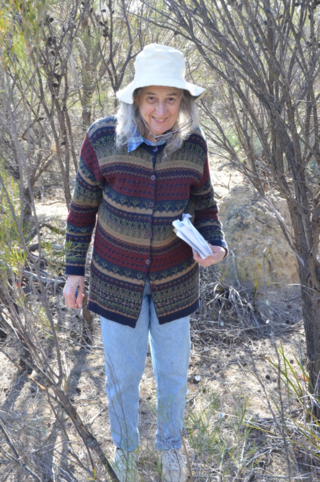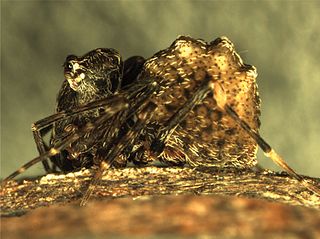
The Mygalomorphae, or mygalomorphs, are an infraorder of spiders, and comprise one of three major groups of living spiders with over 3,000 species, found on all continents except Antarctica. Many members are known as trapdoor spiders due to their creation of trapdoors over their burrows. Other prominent groups include Australian funnel web spiders and tarantulas, with the latter accounting for around one third of all mygalomorphs.

Missulena is a genus of mygalomorph spiders in the family Actinopodidae. It was first described by Charles Walckenaer in 1805, and is a senior synonym of Eriodon. M. tussulena is found in Chile, but the rest are indigenous to Australia. They are sometimes referred to as "mouse spiders" from the now-disproven belief that they dig deep burrows similar to those of mice. Scotophaeus blackwalli is also called a "mouse spider", but it is smaller and not closely related.

Migidae, also known as tree trapdoor spiders, is a family of spiders with about 100 species in eleven genera. They are small to large spiders with little to no hair and build burrows with a trapdoor. Some species live in tree fern stems. They have a Gondwanan distribution, found almost exclusively on the Southern Hemisphere, occurring in South America, Africa, Madagascar, Australia, New Zealand and New Caledonia.

Idiosoma is a genus of Australian armoured trapdoor spiders that was first described by Anton Ausserer in 1871. Originally placed with the Ctenizidae, it was moved to the armoured trapdoor spiders in 1985. The name is derived from the Greek ἴδιος, meaning "individual, unique", and σῶμα, meaning "body", referring to the distinctive structure of the abdomen.
Teyl is a genus of spiders in the family Anamidae. It is endemic to Australia. It is one of the genera that was placed in the former tribe Teylini. The type species is T. luculentus.
Bertmainius is a genus of spiders in the family Migidae. It was first described in 2015 by Mark Harvey, Barbara York Main, Michael Rix and Steven Cooper. As of 2017, it contains 7 species, all from Western Australia.
Moggridgea rainbowi, also called the Australian trapdoor spider, is a small spider endemic to Kangaroo Island in South Australia. The spider was first recorded in 1919.
Bertmainius colonus is a spider in the family Migidae. It was first described in 2015 by Mark Harvey, Barbara York Main, Michael Rix and Steven Cooper, and is endemic to south-western Australia.
Bertmainius monachus is a spider in the family Migidae. It was first described in 2015 by Mark Harvey, Barbara York Main, Michael Rix and Steven Cooper, and is endemic to south-western Australia.
Bertmainius mysticus is a spider in the family Migidae and genus Bertmainius. It was first described in 2015 by Mark Harvey, Barbara York Main, Michael Rix and Steven Cooper, and is endemic to south-western Australia.
Bertmainius opimus is a spider in the family Migidae and genus Bertmainius. It was first described in 2015 by Mark Harvey, Barbara York Main, Michael Rix and Steven Cooper, and is endemic to south-western Australia.
Bertmainius pandus is a spider in the family Migidae, and genus Bertmainius. It was first described in 2015 by Mark Harvey, Barbara York Main, Michael Rix and Steven Cooper, and is endemic to south-western Australia.
Bertmainius tumidus is a spider in the family Migidae. It was first described in 2015 by Mark Harvey, Barbara York Main, Michael Rix and Steven Cooper, and is endemic to South-western Australia.

Barbara Anne York Main was an Australian arachnologist and adjunct professor at the University of Western Australia. The author of four books and over 90 research papers, Main is recognised for her prolific work in establishing taxonomy for arachnids, personally describing 34 species and seven new genera. The BBC and ABC produced a film about her work, Lady of the Spiders, in 1981.

Gaius villosus is a species of spider in the family Idiopidae found in Western Australia in a variety of different habitats.

Zephyrarchaea mainae is a species of spider, informally known as Main's assassin spider, Albany assassin spider, and the Western archaeid spider. The first of the assassin spider family found in Western Australia, the species was unknown until its collection at Torndirrup National Park near Albany was published in 1987.

Avicularioidea is a clade of mygalomorph spiders, one of the two main clades into which mygalomorphs are divided. It has been treated at the rank of superfamily.
Arbanitis montanus is a species of armoured trap-door spider in the family Idiopidae, and is endemic to New South Wales.
Arbanitis melancholicus is a species of armoured trap-door spider in the family Idiopidae, and is endemic to New South Wales.
Cantuaria stewarti is a species of trapdoor spider endemic to New Zealand.









